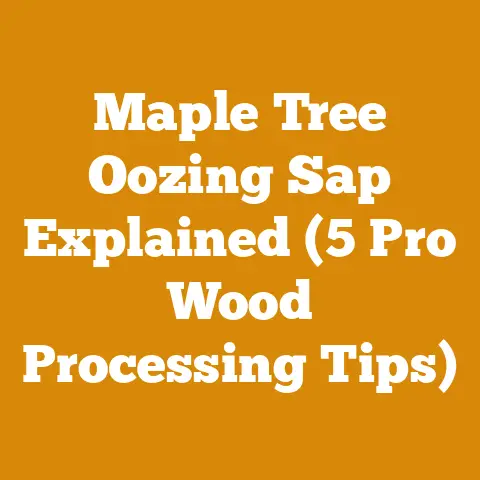Shipping Container Cladding (5 Pro Tips for Durable Wood Finishes)
Let’s dive in and explore how to make your shipping container cladding not just look good, but last for years.
Applying a durable wood finish to your shipping container cladding isn’t just about aesthetics; it’s about protecting your investment from the elements and ensuring longevity.
I’ve seen firsthand how a proper finish can transform a simple container into a beautiful, weather-resistant structure.
Neglecting this crucial step can lead to rot, warping, and costly repairs down the line.
Through years of working with wood and seeing various cladding projects, I’ve learned what works and what doesn’t.
Let me share my top 5 pro tips for achieving a durable wood finish on your shipping container cladding.
Shipping Container Cladding: 5 Pro Tips for Durable Wood Finishes
1. Choosing the Right Wood: Species Selection Matters
Selecting the right wood species is the foundation of a durable cladding.
Not all wood is created equal, especially when exposed to the elements.
I’ve seen projects fail miserably because the wrong type of wood was chosen from the outset.
Understanding Wood Properties:
- Density: Denser woods generally resist rot and insect infestation better than softer woods.
Think about hardwoods like Oak, Iroko, or Teak compared to softwoods like Pine or Fir. - Natural Oils: Some wood species, like Cedar and Redwood, contain natural oils that act as preservatives, making them naturally resistant to decay.
- Grain Structure: A tight, straight grain is less prone to splitting and warping than a loose, irregular grain.
My Recommended Wood Species for Cladding:
- Cedar (Western Red or Alaskan Yellow): This is my go-to choice for many cladding projects.
Its natural oils provide excellent rot resistance, and it’s relatively lightweight and easy to work with.
I’ve used Cedar on numerous container homes, and the results have been consistently impressive.
I’ve even seen Cedar cladding lasting well over 20 years with minimal maintenance. - Redwood: Similar to Cedar, Redwood boasts natural preservatives and a beautiful reddish hue.
However, it can be more expensive and harder to source in some regions. - Accoya: This is a modified softwood (usually Radiata Pine) that undergoes a process called acetylation, which alters its cellular structure, making it incredibly durable and resistant to rot and insects.
It’s a premium option but offers exceptional longevity. - Thermally Modified Wood: Similar to Accoya, thermally modified wood is heat-treated to improve its stability and resistance to decay.
It’s a great alternative to tropical hardwoods. - Iroko: A durable hardwood that is often used as a teak substitute.
It’s known for its resistance to rot and insects, making it a good choice for cladding. - Larch: A more affordable softwood that is naturally durable, especially European Larch.
It can withstand harsh weather conditions and is often used in exterior applications.
Case Study: Cedar vs. Pine
I was once involved in a project where the client insisted on using untreated Pine for the cladding to save costs.
Despite my warnings, they proceeded.
Within two years, the Pine cladding began to show signs of rot and insect damage.
In contrast, a neighboring container home clad in Cedar, treated with a quality stain, looked as good as new after the same period.
This experience solidified my belief in the importance of choosing the right wood species.
Cost Considerations:
While durable hardwoods like Iroko or engineered woods like Accoya offer superior longevity, they come at a higher price point.
Softwoods like Cedar and Larch provide a good balance of durability and affordability.
Remember to factor in the long-term cost of maintenance and replacement when making your decision.
Actionable Steps:
- Research: Investigate the wood species available in your region and their suitability for cladding.
- Consult: Talk to local lumber suppliers and ask for their recommendations based on your climate and budget.
- Sample: Obtain samples of different wood species and expose them to the elements for a few months to observe their performance.
2. Preparation is Key: Surface Preparation and Priming
Proper surface preparation is crucial for achieving a long-lasting finish.
I’ve learned this the hard way after spending countless hours redoing projects where the initial preparation was rushed or neglected.
Cleaning the Wood:
- Remove Debris: Begin by removing any dirt, dust, mildew, or loose fibers from the wood surface.
Use a stiff brush, scraper, or pressure washer (at a low setting to avoid damaging the wood). - Mildew Removal: If mildew is present, use a solution of water and bleach (1 part bleach to 3 parts water) to kill the mold spores.
Rinse thoroughly with clean water. - Sanding: Sanding creates a smooth, even surface that allows the finish to adhere properly.
Start with a coarser grit sandpaper (80-100 grit) to remove any imperfections, then move to a finer grit (120-180 grit) for a smooth finish.
I personally prefer using an orbital sander for larger surfaces, but hand sanding is perfectly acceptable for smaller areas.
Priming:
Priming is an essential step that many DIYers skip, but it significantly improves the adhesion, durability, and appearance of the final finish.
- Benefits of Priming:
- Improved Adhesion: Primer creates a bond between the wood and the topcoat, preventing the finish from peeling or flaking.
- Sealing: Primer seals the wood pores, preventing the finish from being absorbed unevenly.
- Uniform Color: Primer creates a uniform surface for the topcoat, ensuring consistent color and sheen.
- Protection: Some primers contain fungicides and mildewcides, which protect the wood from rot and decay.
- Choosing the Right Primer:
- Oil-Based Primers: These primers offer excellent penetration and adhesion, making them ideal for exterior applications.
However, they can be more difficult to clean up and may require longer drying times. - Water-Based Primers: These primers are easier to clean up and dry faster than oil-based primers.
They are a good choice for projects where VOC emissions are a concern. - Acrylic Primers: These primers are flexible and durable, making them a good choice for wood that is prone to expansion and contraction.
- Oil-Based Primers: These primers offer excellent penetration and adhesion, making them ideal for exterior applications.
- Application: Apply the primer evenly using a brush, roller, or sprayer.
Follow the manufacturer’s instructions for drying times.
My Experience with Primers:
I once used a cheap, water-based primer on a cladding project to save money.
Within a year, the finish began to peel and crack, exposing the wood to the elements.
I had to completely redo the project, using a high-quality, oil-based primer this time.
The difference in the final result was remarkable, and the finish has lasted for years without any issues.
Actionable Steps:
- Clean: Thoroughly clean the wood surface to remove any dirt, debris, or mildew.
- Sand: Sand the wood to create a smooth, even surface.
- Prime: Apply a high-quality primer according to the manufacturer’s instructions.
3. Selecting the Right Finish: Understanding Different Finish Types
Choosing the right finish is critical for protecting your cladding from the elements and achieving the desired aesthetic.
There are several types of finishes available, each with its own advantages and disadvantages.
Types of Finishes:
- Paints: Paints provide excellent coverage and color options.
They form a protective layer on the surface of the wood, shielding it from moisture and UV radiation.
However, paints can be prone to cracking and peeling over time, especially in harsh climates.- Acrylic Latex Paints: These paints are water-based and offer good flexibility and durability.
They are easy to clean up and have low VOC emissions. - Oil-Based Paints: These paints offer excellent adhesion and penetration, making them ideal for exterior applications.
However, they can be more difficult to clean up and may require longer drying times.
- Acrylic Latex Paints: These paints are water-based and offer good flexibility and durability.
- Stains: Stains penetrate the wood, enhancing its natural beauty and providing some protection from the elements.
They are less prone to cracking and peeling than paints, but they offer less UV protection.- Oil-Based Stains: These stains offer excellent penetration and durability.
They enhance the natural grain of the wood and provide a rich, warm color. - Water-Based Stains: These stains are easier to clean up and dry faster than oil-based stains.
They are a good choice for projects where VOC emissions are a concern. - Gel Stains: These stains have a thicker consistency, making them ideal for vertical surfaces.
They provide excellent color control and prevent drips and runs.
- Oil-Based Stains: These stains offer excellent penetration and durability.
- Clear Finishes (Varnishes and Sealers): These finishes provide a transparent protective layer that allows the natural beauty of the wood to shine through.
They offer good UV protection and resistance to moisture.- Spar Varnish: This is a traditional marine varnish that is designed to withstand harsh weather conditions.
It is flexible and durable, making it a good choice for exterior applications. - Polyurethane Varnish: This varnish is durable and water-resistant, making it a good choice for high-traffic areas.
- Penetrating Oil Finishes: These finishes, like Tung oil or Linseed oil, penetrate deep into the wood pores, providing a natural, matte finish.
They require regular maintenance but are easy to reapply.
- Spar Varnish: This is a traditional marine varnish that is designed to withstand harsh weather conditions.
My Preferred Finishes for Cladding:
- Solid Acrylic Stain: I’ve found that solid acrylic stains offer the best combination of durability, UV protection, and aesthetic appeal.
They provide a similar level of coverage to paint but are more flexible and less prone to cracking. - Penetrating Oil Finish with UV Inhibitors: For cladding where you want to highlight the wood’s natural grain, a penetrating oil finish with added UV inhibitors is a good choice.
However, be prepared for regular maintenance.
Case Study: Comparing Different Finishes
I conducted a small experiment where I applied different finishes to Cedar boards and exposed them to the elements for a year.
The results were eye-opening.
The painted board showed significant cracking and peeling, while the stained board faded considerably.
The board treated with solid acrylic stain held up the best, showing minimal signs of wear and tear.
Factors to Consider When Choosing a Finish:
- Climate: Consider the climate in your region.
If you live in an area with harsh weather conditions, you’ll need a finish that offers excellent UV protection and resistance to moisture. - Aesthetic Preferences: Choose a finish that complements the style of your shipping container home.
- Maintenance: Consider the amount of maintenance you’re willing to perform.
Some finishes require more frequent reapplication than others. - Cost: Factor in the cost of the finish when making your decision.
Actionable Steps:
- Research: Investigate the different types of finishes available and their suitability for cladding.
- Test: Apply different finishes to sample pieces of wood and expose them to the elements to see how they perform.
- Choose: Select a finish that meets your needs and preferences.
4. Application Techniques: Achieving a Flawless Finish
Even the best finish will fail if it’s not applied correctly.
Proper application techniques are essential for achieving a durable and aesthetically pleasing result.
Tools and Equipment:
- Brushes: Choose high-quality brushes that are appropriate for the type of finish you’re using.
Natural bristle brushes are best for oil-based finishes, while synthetic bristle brushes are best for water-based finishes. - Rollers: Rollers are ideal for applying finish to large, flat surfaces.
Choose a roller with the appropriate nap length for the type of finish you’re using. - Sprayers: Sprayers can be used to apply finish quickly and evenly.
However, they require more skill and practice to use effectively.
I personally use an airless sprayer for larger cladding projects, as it provides a consistent and professional-looking finish. - Drop Cloths: Protect your work area from spills and splatters.
- Painter’s Tape: Use painter’s tape to mask off areas that you don’t want to be painted or stained.
Application Tips:
- Read the Instructions: Always read and follow the manufacturer’s instructions for the finish you’re using.
- Apply Thin Coats: Apply several thin coats of finish rather than one thick coat.
This will prevent drips, runs, and uneven drying. - Work in the Direction of the Grain: When applying finish with a brush, work in the direction of the wood grain.
This will help to blend the finish and create a smooth, even surface. - Overlap Your Strokes: Overlap your strokes slightly to avoid leaving gaps or streaks.
- Maintain a Wet Edge: Maintain a wet edge to prevent lap marks.
- Sand Between Coats: Sand lightly between coats of finish to remove any imperfections and improve adhesion.
Use a fine-grit sandpaper (220-320 grit). - Clean Your Tools: Clean your tools immediately after use.
Spraying Techniques:
- Proper Setup: Ensure your sprayer is properly calibrated and adjusted for the type of finish you’re using.
- Consistent Distance: Maintain a consistent distance from the surface when spraying.
- Overlapping Passes: Use overlapping passes to ensure even coverage.
- Avoid Runs and Sags: Watch out for runs and sags, and correct them immediately.
My Experience with Application Techniques:
I remember one project where I rushed the application process and applied a thick coat of stain to the cladding.
The stain took forever to dry, and it ended up cracking and peeling in several areas.
I had to completely redo the project, taking my time and applying thin, even coats of stain.
The difference in the final result was significant, and the finish has lasted for years without any problems.
Actionable Steps:
- Gather Your Tools: Gather all the tools and equipment you’ll need for the application process.
- Prepare Your Work Area: Protect your work area from spills and splatters.
- Apply the Finish: Apply the finish according to the manufacturer’s instructions, using proper application techniques.
5. Maintenance and Upkeep: Extending the Life of Your Finish
Even the most durable finish will eventually require maintenance.
Regular maintenance is essential for extending the life of your finish and protecting your cladding from the elements.
Regular Cleaning:
- Wash the Cladding: Wash the cladding regularly with a mild soap and water solution.
This will remove dirt, dust, and mildew. - Pressure Washing: Use a pressure washer to clean the cladding, but be careful not to damage the wood.
Use a low-pressure setting and a wide nozzle.
Inspecting for Damage:
- Check for Cracks and Peeling: Inspect the cladding regularly for cracks, peeling, or other signs of damage.
- Address Problems Promptly: Address any problems promptly to prevent them from getting worse.
Reapplication:
- Reapply Finish as Needed: Reapply finish as needed to maintain its protective properties.
The frequency of reapplication will depend on the type of finish you’re using and the climate in your region. - Spot Repairs: Spot repair any areas that are damaged or worn.
My Maintenance Routine:
I typically wash my cladding once a year with a mild soap and water solution.
I also inspect it regularly for any signs of damage.
Every 3-5 years, I reapply a fresh coat of finish to keep it looking its best.
Case Study: The Importance of Maintenance
I have two container homes with similar cladding, both finished with the same solid acrylic stain.
One homeowner diligently maintains their cladding, washing it regularly and reapplying finish as needed.
The other homeowner neglects their cladding.
After five years, the cladding on the well-maintained container home looks as good as new, while the cladding on the neglected container home is faded, cracked, and peeling.
Actionable Steps:
- Establish a Maintenance Routine: Establish a regular maintenance routine for your cladding.
- Inspect Regularly: Inspect the cladding regularly for any signs of damage.
- Address Problems Promptly: Address any problems promptly to prevent them from getting worse.
By following these 5 pro tips, you can achieve a durable and beautiful wood finish on your shipping container cladding that will last for years to come.
Remember, choosing the right wood, preparing the surface properly, selecting the right finish, applying it correctly, and maintaining it regularly are all essential for success.
Now, go forth and create a stunning and long-lasting cladding for your shipping container project!






